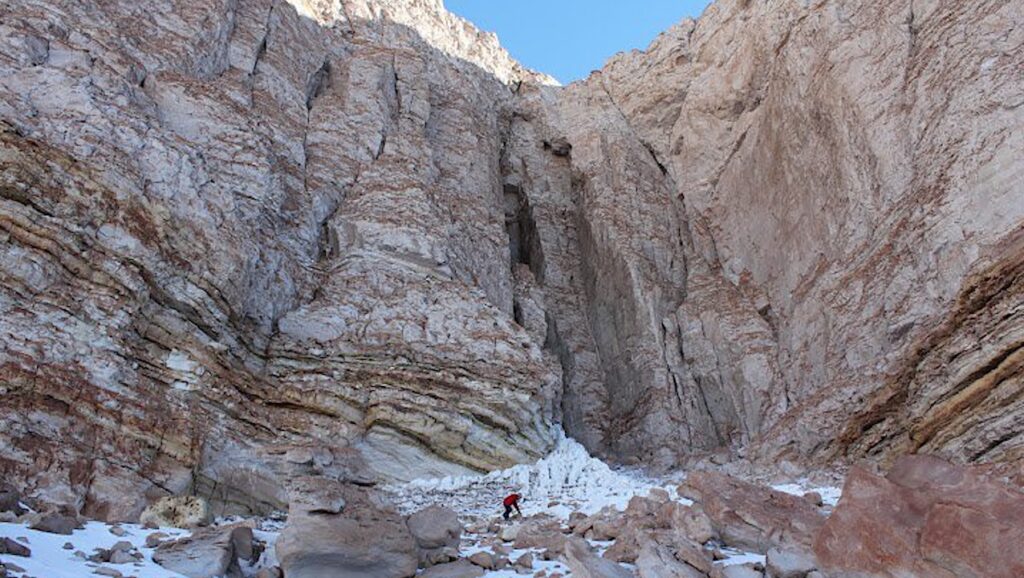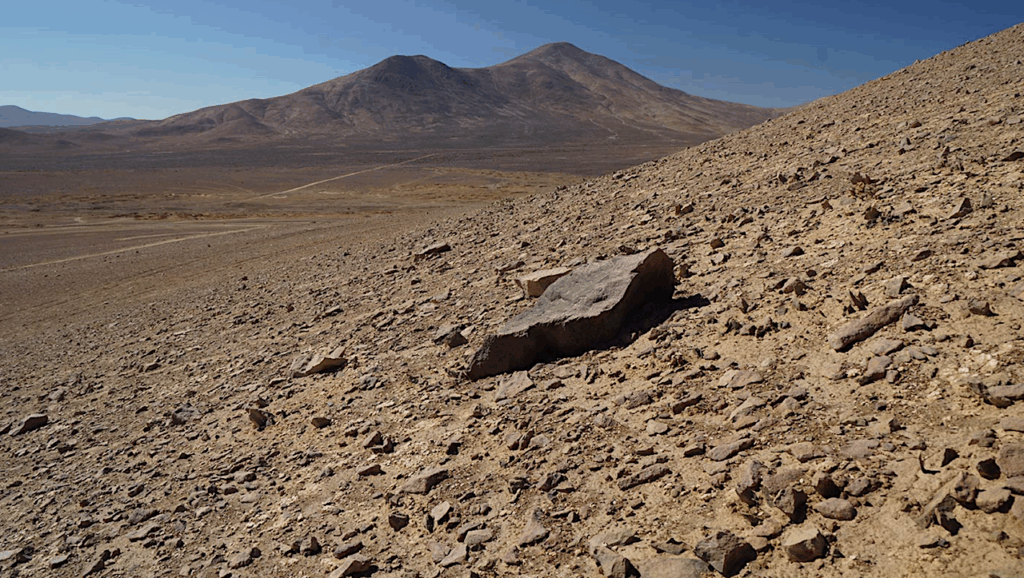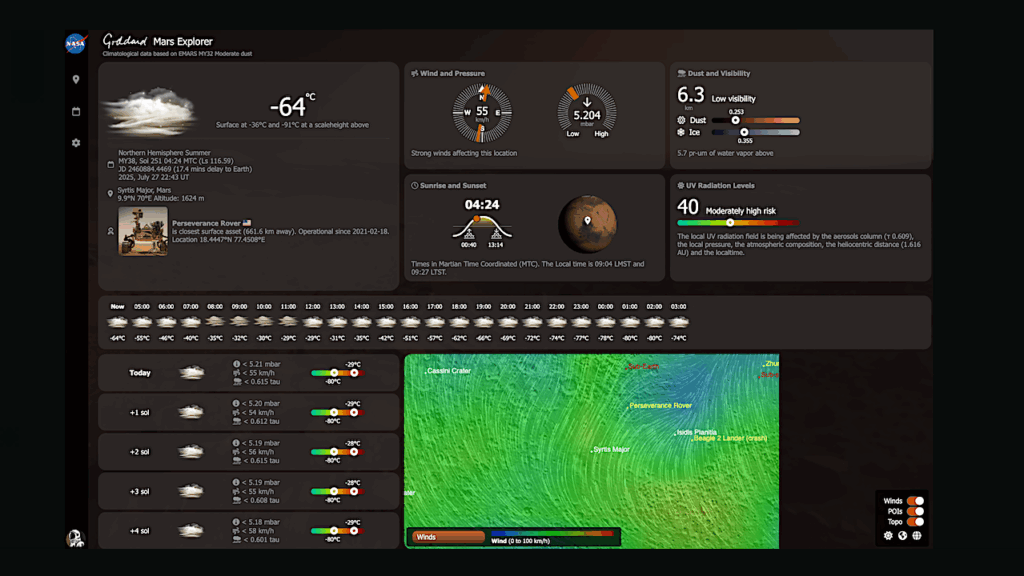Swiss Geologists Find A Mars Meteorite In Oman

Geologists from Bern University and from the Natural History Museum Bern have found more than 180 meteorites in Oman in January/February 2001.
The most exciting find is a piece of Mars rock. This meteorite just received its name: Sayh al Uhaymir 094. Contrary to other finds of Mars meteorites in deserts, this meteorite is fully available to science. Detailed investigations are currently under way at Bern University and at collaborating institutions.
Just 18 meteorites from Mars are known today. Some have been fragmented during their fall. Sayh al Uhaymir 094 is a fragment of the 16th known Mars meteorite. The geologic past of Mars, including the fate of water, as well as the search for evidence of possible past life on Mars are research areas in which Mars meteorites play a key role. Meteorites from the red planet are of extreme scientific value because they are the only solid material available for about 10 years to come. If all goes well, about 500 g of Mars samples will then be returned to Earth at very high costs by spacecraft.
Sayh al Uhaymir 094: a window into Mars’s past
SaU 094 is, besides the antarctic finds, the only Mars meteorite fully available to science. Applying modern analytical tools at Bern University, the mineralogical characterization was possible using tiny fragments. The nature of the minerals as well as their chemical composition clearly demonstrate that SaU 094 is a Mars meteorite. It is a piece of rock that was formed from molten lava, similar to volcanic rocks on Earth. The origin from Mars is supported by measurements of oxygen isotopes (Ian Franchi, Open University, UK). Using X-ray tomography at EMPA, D¸bendorf (Switzerland), the interior of the rock was investigated nondestructively. An interesting result of this investigation is the occurrence of many cavities up to several millimetres in size, probably an effect of intense mechanical stress during ejection from Mars. For detailed analyses samples will be cut from this stone. The majority of these analyses (mineralogy, chemical composition, noble gases, age determination etc) will be conducted at Bern University. The availability of SaU 094 provides a new focal point for Swiss Mars science.
Why are so many meteorites found in Oman? Meteorite falls are very rare. Only where the surface of the Earth remains undisturbed and dry for very long times meteorites accumulate over thousands of years. Enrichments of this type were first detected in Antarctica and since about 10 years deserts are being searched for meteorites systematically. From the Sahara about 2000 meteorites are known already. The Sultanate of Oman has become known as an important collection area for meteorites just in the past two years. It is spectacular that in this short time six Lunar and two Martian meteorites have been found in Oman. All meteorite searches so far have been conducted without permission from the Omani authorities. The meteorite Sayh al Uhaymir 094 was published in the Meteoritical Bulletin on may 23, 2001. The official text from the Bulletin is given below:
THE METEORITICAL BULLETIN
Announcement 85-5, May 23, 2001
Jeffrey N. Grossman, Editor
Jutta Zipfel, Co-editor for Saharan Meteorites
Sayh al Uhaymir 094 20 deg 59.469 min N, 57 deg 20.326 min E
Oman
Found 2001 February 8
Martian meteorite (shergottite)
A 223.3 g partially crusted stone was found in the same area as Sayh al Uhaymir 005, 008, and 051 by Marc Hauser and Lorenz Moser (Bern) during a search for meteorites. All samples may be paired. Mineralogy and classification (E. Gnos, Institute for Geological Sciences, Bern) and B. Hofmann (NMB): the grey-greenish rock shows a gabbro-like texture and contains phenocrysts of olivine (average maximum dimension = 1.5 mm) displaying shock-twinning, mosaicism, and, locally, oxidation; optically clear parts of olivines (Fo65-69) occur in a fine-grained (average maximum grain size = 0.3 mm) groundmass consisting of maskelynite (An55-64Or5-9) and pigeonite (En60-68Wo7-9) with minor augite, chromite and pyrrhotite; partially recrystallized veins and pockets of shock-melted glass containing vescicles are abundant; x-ray tomography revealed that the specimen contains approximately 0.4 vol% of pores up to 3 mm in size; shock stage, S5; weathering grade, W1; small rusty pockets are Fe-hydroxide replacements of an unknown pre-existing phase. Specimens: all in NMB.
Fascination Mars
The red planet exerts great fascination to humans since antiquity. What is the justification, however, to investigate such a distant object in detail? The history of planet Earth can only be understood in context with the common origin with other planets and with the sun 4600 million years ago. >From all the planets Mars is most earthlike. There is evidence indicating that both planets developped in a similar way for the first 1000 million years, a time during which life established itself on Earth. The recent recognition of extreme environments of life on Earth, e.g. in submarine springs at 110 C and in porous rocks several kilometers below the surface demonstrates that Early Mars most likely offered environments prone for Life.
18 Meteorites are the only objects from planet Mars currently available. Every piece provides new insight into the origin and development of our neighbour planet. Additionally, meteorites represent potential “spaceships” for microbes. Detailed studies of all processes affecting meteorites during their journey yields answers to the question of whether interplanetary transfer of microbes is a likely process.
How are Mars meteorites delivered to Earth?
Fragments of planet Mars are naturally delivered to Earth. Impacts of large meteorites on Mars produce craters. Rocks close to craters may be ejected with high velocity. To escape the gravity field of Mars, a velocity of at least 5 km per second (approx. 20,000 km/h) is necessary. Ejected rock fragments may approach Earth after millions of years, enter the atmosphere, and end up as a piece of rock in the desert. Research on Mars meteorites (e.g. at the Institute of Physics of Bern University) demonstrates that the transfer between Mars and Earth took between 0.7 and 20 million years for different meteorites.
Mars research: International efforts Since the announcement of possible traces of life in the antarctic Mars meteorite ALH84001 in 1996 Mars research has boomed. Even though the arguments presented in 1996 are hardly taken as solid evidence today, this and consecutive studies have initiated a new era of Mars research pushing, among other things, the foundation of the NASA Astrobiology Institute (NAI). In Europe the European Astrobiology Network was founded in May 2001.
New Mars meteorites were found in increasing rates in the last years, and several missions to Mars (some successful, others not) were undertaken. One mission (Mars Odyssey 2001) is currently on the way to Mars. Three missions will attempt to reach Mars in December 2003 and January 2004, among them ESA’s Mars Express with the lander Beagle 2. NASA’s Mars Global Surveyor is orbiting Mars since 1997 and is providing a wealth of new data about the Martian surface.
Mars research in Switzerland
Different scientific institutions are busy with Mars research also in Switzerland. Mars meteorites are being studied since many years in the group of Prof. O. Eugster at Bern University. Here noble gas contents are measured, allowing a determination of the time the meteorite was exposed to the space environment, and with that, the ejection age from Mars. At ETH Zurich rare isotopes are being determined in Mars meteorites. For the Mars lander Beagle 2 the Swiss electronics/microtechnics company CSEM in Neuch‚tel provides the cameras for panoramic, close-up and microscopic imaging. In collaboration with CSEM test images of terrestrial materials are being made at the Natural History Museum Bern. There will be a press orientation about the involvement of CSEM in the Beagle 2 mission on June 15, 2001 at 16.00 in Neuch‚tel (see link in website).
The science team
Bern University conducts intensive research in the Sultanate of Oman since more than 30 years and has made a significant contribution to the development of this modern state. Besides geological mapping and prospection for raw materials, research was mainly focused on subjects like origin of the Oman Mountains, palaeoclimate and ground water resources. Students from Oman are integrated in ongoing projects and receive training at Bern University. Many of these projects were supported by the Swiss National Science Foundation. Thanks to these longstanding good relations with the Sultanate of Oman, the first official meteorite search project could be realized in January/February 2001.
Astrobiology








